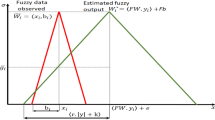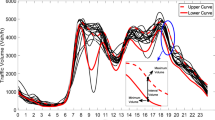Abstract
Traffic congestion state identification is one of the most important tasks of ITS. Traffic flow is a nonlinear complicated system. Traffic congestion state is affected by many factors, such as road channelization, weather condition, drivers’ different driving behavior and so on. It is difficult to collect all necessary traffic information. Traffic congestion auto identification result based on incomplete traffic information exists uncertain. Little work has been done to analyze the uncertainty. Possibility theory introduced by Zadeh is an efficient means to present incomplete knowledge. Possibility distribution determination is an important task of possibility theory. In this paper, possibility theory is used to describe the uncertainty of traffic state. The possibility distribution of traffic state is determined according to the probability distribution of traffic flow parameters, such as volume, speed and occupancy and so on. The multi-variable distribution of traffic flow parameters is determined with large-scale traffic flow data. Large-scale traffic congestion samples are generated with parallel k-mean clustering method. Traffic congestion forecasting is based on the forecasting of traffic flow parameters with SVM (Support Vector Machines). At last, a practical example is analyzed with the proposed method.





Similar content being viewed by others
References
Yang, Z.S.: Basis traffic information fusion technology and its application. China Railway Publish House, Beijing (2005)
Persaud, B., Hall, F., Hall, L.: Congestion identification aspects of the McMaster detection algorithm. Transplant. Res. Rec. 1287, 167–175 (1990)
Dudek, C., Messer, C., Nuckles, N.: Incident detection on urban freeways, pp. 12–24. Transportation Research Record, Washington (1974)
Zadeh, L.A.: Fuzzy sets as a basis for a theory of possibility. Fuzzy Set. Syst. 1, 3–28 (1978)
Dubois, D., Prade, H.: When upper probabilities are possibility measures. Fuzzy Set. Syst. 49, 65–74 (1992)
Dubois, D., Prade, H.: Fundamentals of fuzzy sets. The Handbooks of Fuzzy Sets Series, Kluwer (2000). 343–438
Dubois, D.: Possibility theory and statistical reasoning. Fuzzy Stat. Anal. 51(1), 47–69 (2006)
Dubois, D. Prade, H.: Possibility theory: an approach to computerized processing of uncertainty. Plenum Press (1988)
Dubois, D., Nguyen, H.T., Prade, H.: Fuzzy sets and probability: misunderstanding, bridges and gaps, pp. 343–438. Fundamentals of Fuzzy Sets, Kluwer (2000)
Masson, M., Denoeux, T.: Inferring a possibility distribution from empirical data. Fuzzy Set. Syst. 157, 319–340 (2005)
Dubois, D., Prade, H.: Possibility theory and its applications: A retrosptective and prospective view. The IEEE international conference on fuzzy systems 3–11 (2010)
Ranjan, M., Peterson, A.D.,Ghosh, P.A.: A systematic evaluation of different methods for initializing the K-means clustering algorithm. IEEE transaction on knowledge and data engineering 522–537 (2010)
Zhao, W.Z., Ma, H.F., He, Q.: Parallel K-means clustering based on MapReduce. Lect. Notes Comput. Sci. Vol. 5931, 674–679 (2009)
Cortes, C., Vapnik, V.: Support vector networks. Mach. Learn. 20, 273–297 (1995)
Chang, C.C., Lin, C.J.: LIBSVM: a library for support vector machines. ACM Trans. Intell. Syst. Technol. 27(2), 1–27 (2011)
Ekanayake, J., Li, H. et al.: Twister: A runtime for iterative MapReduce. The First International Workshop on MapReduce and its Applications of ACM HPDC, ACM press 810–818 (2010)
Acknowledgments
This work is partially supported by national youth science foundation (No. 61004115), national science foundation (No. 61472230), and national science foundation (No. 61272433).
Author information
Authors and Affiliations
Corresponding author
Rights and permissions
About this article
Cite this article
Sun, Z., Li, Z. & Zhao, Y. Traffic Congestion Forecasting Based on Possibility Theory. Int. J. ITS Res. 14, 85–91 (2016). https://doi.org/10.1007/s13177-014-0104-1
Received:
Revised:
Accepted:
Published:
Issue Date:
DOI: https://doi.org/10.1007/s13177-014-0104-1




